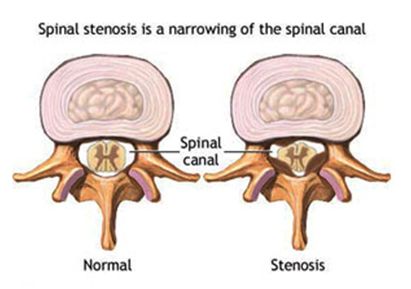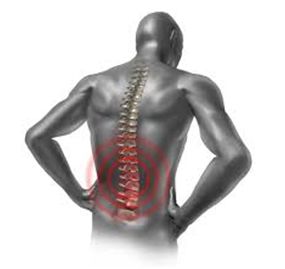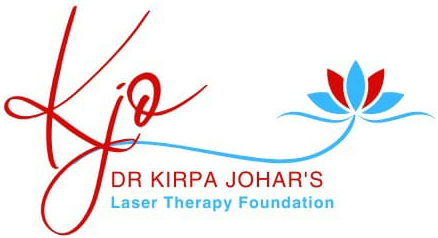Spinal stenosis is a narrowing of the open spaces within your spine, which can put pressure on your spinal cord and the nerves that travel through the spine. Spinal stenosis occurs most often in the neck and lower back.

Difference between normal and stenosis affected spine
Symptoms include pain, numbness, paraesthesia, and loss of motor control. The location of the stenosis determines which area of the body is affected.
Spinal stenosis is most commonly caused by wear-and-tear changes in the spine related to aging.
Symptoms
Symptoms vary, depending on the location of the stenosis:
- In the Neck Narrowing in the upper (cervical) spine can cause numbness, weakness or tingling in a leg, foot, arm or hand. In severe cases, nerves to the bladder or bowel may be affected, leading to incontinence.
- In the Lower Back Compressed nerves in your lower (lumbar) spine can cause pain or cramping in your legs when you stand for long periods of time or when you walk. The discomfort usually eases when you bend forward or sit down.

Spinal stenosis pain
Causes
Spinal stenosis occurs when something happens to reduce the amount of space available within the spine. Causes of spinal stenosis may include:
- Disk Degeneration
- Thickening of the Ligaments
- Osteoarthritis
- Herniated or Bulging Discs
- Bony Growths (spurs)
- Facet Joint wearing or overgrowth
- Scar Tissue
- Bone Slippage (Spondylolisthesis)
- Spinal Tumors
- Trauma to the spine, Fractures
Diagnosis
Diagnosis is done with help of medical history, physical examination, MRI and CT myelogram
Treatment
The type of treatment you receive for spinal stenosis may vary, depending on the location of the stenosis and the severity of your signs and symptoms.
Medications
To control pain associated with spinal stenosis, your doctor may prescribe:
- NSAIDs
- Muscle relaxants
- Antidepressants
- Anti-seizure drugs
- Opioids
Therapy
Physical therapy may help to:
- Build up your strength and endurance
- Maintain the flexibility and stability of your spine
- Improve your balance
Steroid injections
Surgery
Low Level Laser Therapy Treatment for Spinal Stenosis
Low Level Laser Therapy (LLLT) is the application of red and near infrared light over injuries to stimulate cellular repair.
The laser device is held over the area to be treated, against the skin, and the low-level lasers emit penetrating light in the visible red and near infra-red spectrum (380/400nm-1000nm) deep into the tissues.
The energy is absorbed in the tissues and converted into biochemical energy, thus stimulating the activity of the cells in the damaged area and promoting connective tissue repair process.
LLLT has a beneficial anti-inflammatory and pain attenuation effect.
The main benefit of LLLT is that it is relatively non-invasive and has the ability to treat nerve injuries without surgical intervention thus making it a desirable treatment option.
LLLT has no known side effects, is safe and effective.
